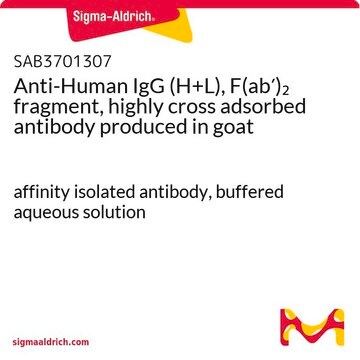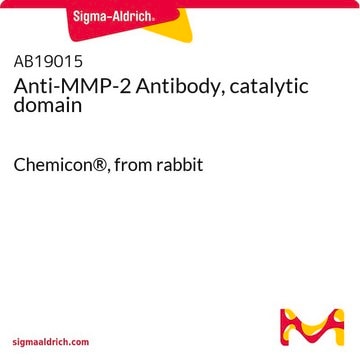SAB4700666
Monoclonal Anti-Cytokeratin (Pan-reactive) antibody produced in mouse
clone C-11, purified immunoglobulin, buffered aqueous solution
Synonyma:
Mouse Anti-Cytokeratin, Pan-reactive Cytokeratin Detection
Přihlásitk zobrazení cen stanovených pro organizaci a smluvních cen
About This Item
UNSPSC Code:
12352203
NACRES:
NA.41
Doporučené produkty
biological source
mouse
conjugate
unconjugated
antibody form
purified immunoglobulin
antibody product type
primary antibodies
clone
C-11, monoclonal
form
buffered aqueous solution
species reactivity
mammals
concentration
1 mg/mL
technique(s)
flow cytometry: suitable
isotype
IgG1
shipped in
wet ice
storage temp.
2-8°C
target post-translational modification
unmodified
Gene Information
human ... KRT1(3848)
General description
Cytokeratins also known as keratins are filament-forming proteins of epithelial cells. In humans, there are 54 cytokeratins. These proteins are divided in to two sub-categories such as acidic type I keratins and basic-to-neutral type II keratins.
The antibody C-11 reacts with Cytokeratin peptides 4, 5, 6, 8, 10, 13, 18. Cytokeratins are a member of intermediate filaments subfamily represented in epithelial tissues.
Immunogen
Keratin-enriched preparation from human epidermoid carcinoma cell line A431
application
Monoclonal Anti-Cytokeratin (Pan-reactive) antibody produced in mouse has been used in immunocytochemistry.
The reagent is designed for Flow Cytometry analysis. Suggested working dilution for Flow Cytometry is 0.5 μg/mL of sample. Indicated dilution is recommended starting point for use of this product. Working concentrations should be determined by the investigator.
Biochem/physiol Actions
Cytokeratins play an essential role in normal tissue structure and function. It also facilitates the maintenance of cell mechanical integrity.
Features and Benefits
Evaluate our antibodies with complete peace of mind. If the antibody does not perform in your application, we will issue a full credit or replacement antibody. Learn more.
Physical form
Solution in phosphate buffered saline, pH 7.4, with 15 mM sodium azide.
Disclaimer
Unless otherwise stated in our catalog or other company documentation accompanying the product(s), our products are intended for research use only and are not to be used for any other purpose, which includes but is not limited to, unauthorized commercial uses, in vitro diagnostic uses, ex vivo or in vivo therapeutic uses or any type of consumption or application to humans or animals.
Ještě jste nenalezli správný produkt?
Vyzkoušejte náš produkt Nástroj pro výběr produktů.
Storage Class
10 - Combustible liquids
flash_point_f
Not applicable
flash_point_c
Not applicable
Vyberte jednu z posledních verzí:
Již tento produkt vlastníte?
Dokumenty související s produkty, které jste v minulosti zakoupili, byly za účelem usnadnění shromážděny ve vaší Knihovně dokumentů.
New consensus nomenclature for mammalian keratins
Schweizer J
The Journal of Cell Biology, 174, 169-174 (2006)
Cytokeratin expression, fibrillar organization, and subtle function in liver cells
Marceau N and Loranger A
Biochemistry and Cell Biology = Biochimie Et Biologie Cellulaire, 73, 619-625 (1995)
Evaluation of a simple method for storage of blood samples that enables isolation of circulating tumor cells 96 h after sample collection
Apostolou P
Journal of biological research (Thessalonike?, Greece) (2017)
Panagiotis Apostolou et al.
Journal of biological research (Thessalonike, Greece), 24, 11-11 (2017-10-05)
Minimizing the effects of transportation on the properties of biological material is a major challenge for the scientific community. The viability of cells is important in cases where their study is urgent for evaluation of treatment response or for the
Stefano Guadagni et al.
BMC cancer, 22(1), 660-660 (2022-06-17)
Patients with unresectable recurrent rectal cancer (RRC) or colorectal cancer (CRC) with liver metastases, refractory to at least two lines of traditional systemic therapy, may receive third line intraarterial chemotherapy (IC) and targeted therapy (TT) using drugs selected by chemosensitivity
Náš tým vědeckých pracovníků má zkušenosti ve všech oblastech výzkumu, včetně přírodních věd, materiálových věd, chemické syntézy, chromatografie, analytiky a mnoha dalších..
Obraťte se na technický servis.








